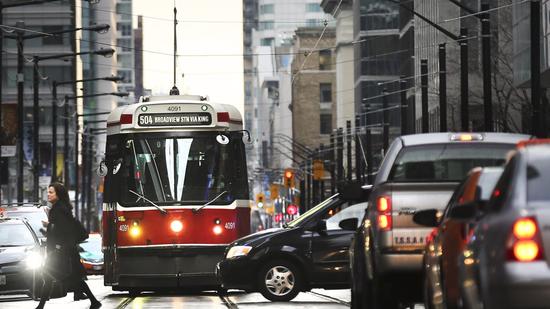Oh, Canada! Toronto Beats Chicago
on Transit with More Riders, Funding

A streetcar makes its way through traffic along King street at Bay.
(Richard Lautens / Toronto Star)
 Mary Wisniewski Contact Reporter
Mary Wisniewski Contact ReporterChicago Tribune
Toronto is a Great Lakes city like Chicago in many ways: It has about the same population, hot summers, freezing winters and a colorful patchwork of ethnic neighborhoods.
But there are differences north of the border. The money is prettier. Crime is less violent. Milk comes in plastic bags.
One major contrast is in the sister cities' transit systems. Despite having fewer rail lines and stations, Toronto's public transit ridership has seen years of steady passenger growth — up 15 percent from 2008 to 2015, while the CTA's is down 1.6 percent over the same period. With 2.7 million daily boardings compared with the CTA's 1.6 million, the Toronto Transit Commission, or TTC, has become the busiest system in North America, after New York City and Mexico City.
TTC also is getting billions in capital dollars from the province of Ontario for service expansion, while Springfield lacks a current capital program. The entire Toronto region is undergoing a transit revolution and offers an example of what can be done for transit, if the political will and money are available.
Yonah Freemark, project manager of Chicago's Metropolitan Planning Council, said that continued investments in improving service, coupled with a growing population and development planning that links residents to transit lines, all are boosting use of Toronto's system.
"We really need to campaign for the state to provide more funding for transit services — buses and rail," Freemark said. The council has been pushing for $43 billion in new capital funding for transportation infrastructure over the next decade.
The capital connection
Unlike Illinois, which has no current capital plan because of the state budget impasse, Ontario has committed $8.4 billion in support of new transit in Toronto. The province is putting $31.5 billion in capital investments over 10 years to build an integrated provincial transportation network. The total package includes improvements to roads and bridges and to the frequency of GO trains — Toronto's equivalent to Metra.

Canada is poised to become North America's new cannabis capital
The money specifically for the TTC includes $5.3 billion for the Eglinton Crosstown, an 11.8-mile light rail line that will be the largest transit expansion in the city's history, to be completed in 2021.
An additional $2.1 billion is going to two other light rail lines. The TTC and the city are in the early stages of planning a new "relief" subway line to manage subway congestion downtown, and an extension to the Scarborough area, which will cost $3.56 billion in city, provincial and federal funds.
Due to open late next year is a 5.3-mile extension on the city's main Yonge-University line, built with provincial, federal and local funds.
New project funding is separate from the TTC's $9 billion 10-year capital program for maintaining the system, building elevators and buying streetcars, TTC spokesman Brad Ross said. The TTC is $2.7 billion shy for this program but proceeding as it can.
In contrast, the CTA needs $13 billion over the next 10 years to keep its much older system in a state of good repair. Its last all-new line, the Orange Line, opened in 1993.

Hate center-facing? Take a seat on 130 years of 'L' trains
The CTA committed $5 billion in the last five years to rehabbing stations and other improvements. It wants to invest more to improve service — a big initiative is the $2.13 billion Red and Purple Line modernization project to rebuild tracks that are more than a century old.
But the agency lacks a reliable source of capital funding. It has a pledge of $1 billion in federal money, but that isn't guaranteed without a local match.
CTA spokeswoman Tammy Chase said the stop-and-start nature of capital funding makes it difficult to plan effectively.
"You have to constantly hope and work for funding, and you don't have the stable funding stream," Chase said.
The Toronto way
Toronto's system is slightly more expensive to ride than Chicago's. The adult cash price is $3.25 in Canadian dollars or about $2.52 in U.S. dollars, compared with $2.25 for the Chicago "L." Most Toronto riders use a monthly Metropass for $141.50, or about $110 in U.S. currency. The CTA 30-day pass costs $100.
TTC transfers are free, as are rides for children younger than 12, and there's a discount for college students. Fares cover about two-thirds of operations, while the city covers the other third, plus most good repair projects.
TTC's rail system is smaller — with four lines and 69 stations compared with the CTA's eight lines and 145 stations. TTC rail does not extend into the suburbs as the CTA does, and shuts down at night for maintenance, unlike CTA Blue and Red line trains, which run 24 hours.
The TTC can seem oddly inadequate — rail stations don't open until 8 a.m. on Sundays.
But Toronto does have a larger network of bus and streetcar service with about 170 routes, said Ross, compared with the CTA's 130 bus routes. Night service is offered through a network of buses and streetcars.
Ross noted that TTC service was cut under the former mayor, the controversial Rob Ford, who died earlier this year. The current mayor, John Tory, reinstated service that was cut. He also wants a separate initiative called SmartTrack, which would adapt a commuter rail corridor for urban use, with electrification and more stops.
TTC growth
One reason TTC's ridership is growing is because the city is. Toronto has 2.86 million people, according to the World Population Review, up from 2.5 million in 2006. Chicago's population has slipped to 2.72 million, according to U.S. Census data.
Toronto also has less highway capacity than Chicago, and rush hour traffic is horrendous.
"Because Toronto has fewer highways, it's encouraging people to take transit," Freemark said. About 68 percent of Toronto morning commuters use transit, said chief planner Jennifer Keesmaat. That's compared with 28 percent of Chicago commuters, according to 2014 Census figures. Of Toronto public transit commuters, 85 percent use the TTC, Ross said.
Another factor is Toronto's strategy of linking new development with transit corridors, Keesmaat said. Transit-oriented development — putting dense retail and residential development near train stations to encourage people to ditch their cars — is starting to happen in Chicago, with high-rises springing up near "L" stations.
But in Toronto, high-density development near transit corridors is part of a 10-year-old plan, Keesmaat said. The city has reduced requirements for parking spaces, and 80 percent of growth is on main transit corridors.
"As we grow, we want to not add cars but provide the option for people to primarily get around on transit," Keesmaat said. "We've linked our transit capital building projects to the vision of the city we're trying to create."
Freemark said improved bus service also is a factor in TTC's progress. CTA bus ridership has dropped while its rail ridership has gone up.
The TTC can be too popular, and rush hour trains and streetcars get "squishy," which shows the need for more capacity, Keesmaat said.
Besides the line expansions, the TTC is growing space for riders through investing in new train control technology that will allow more trains to run per hour, and adding new streetcars and trains with more room onboard, Ross said.
For example, newer trains on the system lack doors between cars, which allows riders to look down the entire train from end to end. This allows for about 10 percent more capacity, Ross said.
There are some hard choices ahead. Metrolinx, Ontario's regional transit agency, has been developing a plan to merge the fare systems of the Toronto region's transit operators.
A possible scenario would be to change the TTC's flat fare model, similar to the CTA's, to a distance-based model. But the TTC says this would require major renovations, and community activists fear it would result in big fare hikes.
A recent softening of TTC ridership may be caused by the economy slowing, or some people peeling off to take Uber or biking, Ross said. TTC riders gripe about their system just like CTA riders do. They complain about overcrowding, system breakdowns, riders who evade fares, and those who talk too loud or eat smelly food on the trains.
But TTC riders do have something to look forward to — big expansions to a system that most residents depend on every day.
"There's a big modernization effort going on," Ross said. "It does take time, though. It's a big ship to turn around."
Kyle Whitehead, campaign director for the Active Transportation Alliance, said the Chicago region needs to imitate Toronto in thinking bigger about transit improvement and expansion.
"There's been such stagnation in recent decades, I think a lot of people in Chicago think that's the way it is and that's the way it's always going to be," Whitehead said.
"If we can move forward with projects like Ashland Avenue bus rapid transit service, and other expansion projects, people will see the improvements and see more areas clamoring for improvements," Whitehead said. "I think that's what's happening in Toronto."
mwisniewski@tribpub.com